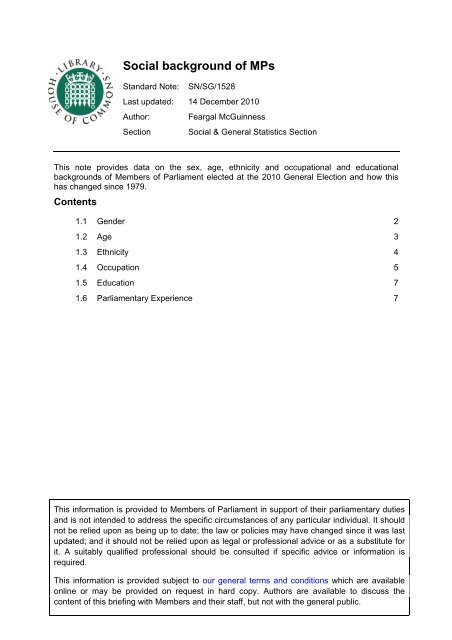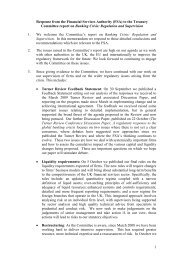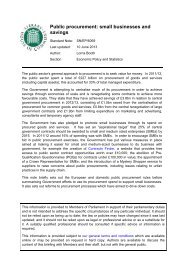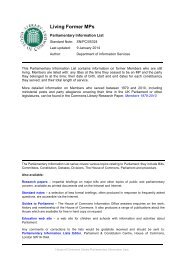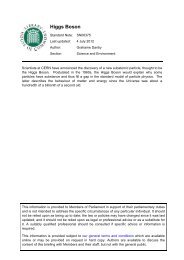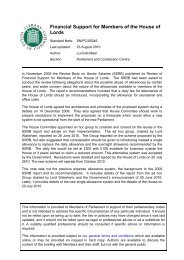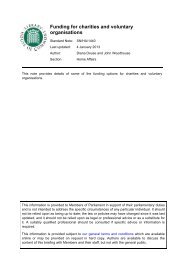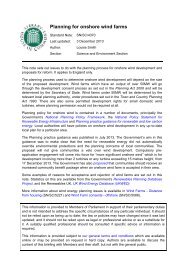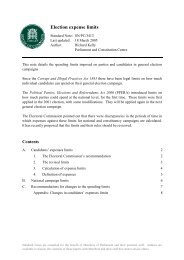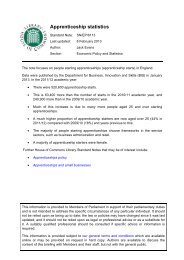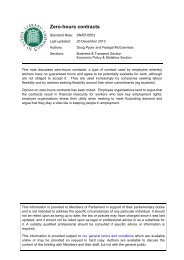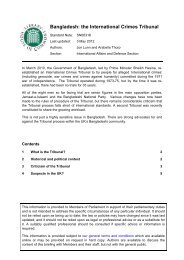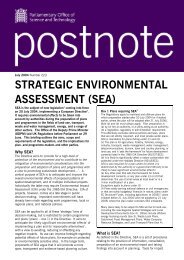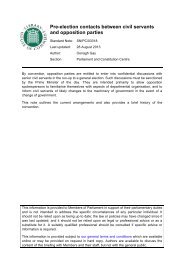Social background of MPs - Parliament
Social background of MPs - Parliament
Social background of MPs - Parliament
Create successful ePaper yourself
Turn your PDF publications into a flip-book with our unique Google optimized e-Paper software.
<strong>Social</strong> <strong>background</strong> <strong>of</strong> <strong>MPs</strong><br />
Standard Note: SN/SG/1528<br />
Last updated: 14 December 2010<br />
Author: Feargal McGuinness<br />
Section <strong>Social</strong> & General Statistics Section<br />
This note provides data on the sex, age, ethnicity and occupational and educational<br />
<strong>background</strong>s <strong>of</strong> Members <strong>of</strong> <strong>Parliament</strong> elected at the 2010 General Election and how this<br />
has changed since 1979.<br />
Contents<br />
1.1 Gender 2<br />
1.2 Age 3<br />
1.3 Ethnicity 4<br />
1.4 Occupation 5<br />
1.5 Education 7<br />
1.6 <strong>Parliament</strong>ary Experience 7<br />
This information is provided to Members <strong>of</strong> <strong>Parliament</strong> in support <strong>of</strong> their parliamentary duties<br />
and is not intended to address the specific circumstances <strong>of</strong> any particular individual. It should<br />
not be relied upon as being up to date; the law or policies may have changed since it was last<br />
updated; and it should not be relied upon as legal or pr<strong>of</strong>essional advice or as a substitute for<br />
it. A suitably qualified pr<strong>of</strong>essional should be consulted if specific advice or information is<br />
required.<br />
This information is provided subject to our general terms and conditions which are available<br />
online or may be provided on request in hard copy. Authors are available to discuss the<br />
content <strong>of</strong> this briefing with Members and their staff, but not with the general public.
1.1 Gender<br />
In 2010, there are 143 women <strong>MPs</strong> (22% <strong>of</strong> all <strong>MPs</strong>), the highest ever number and<br />
proportion. In 1979 there were 19 women <strong>MPs</strong>, 3% <strong>of</strong> the total. The number <strong>of</strong> women <strong>MPs</strong><br />
rose slowly over the next three parliaments to 60 in 1992. The 1997 Labour landslide was<br />
accompanied by a doubling <strong>of</strong> the number <strong>of</strong> women <strong>MPs</strong> to 120 (it rose during the 97-01<br />
<strong>Parliament</strong> to 122 following the election <strong>of</strong> two women at by-elections). That number fell<br />
back to 118 after the 2001 election but rose again in 2005 and 2010. Figures for the start <strong>of</strong><br />
each <strong>of</strong> the last eight <strong>Parliament</strong>s are given in Table 1.<br />
Table 1 Men and Women <strong>MPs</strong> 1979 to 2010<br />
Election Men Women Total % women<br />
1979 616 19 635 3%<br />
1983 627 23 650 4%<br />
1987 609 41 650 6%<br />
1992 591 60 651 9%<br />
1997 539 120 659 18%<br />
2001 541 118 659 18%<br />
2005 518 128 646 20%<br />
2010 507 143 650 22%<br />
As Table 2 and Figure 1 show, the majority <strong>of</strong> female <strong>MPs</strong> have been Labour <strong>MPs</strong>. This has<br />
particularly been the case since 1997.<br />
Table 2 Women <strong>MPs</strong> by party 1979 to 2010<br />
Number<br />
% <strong>of</strong> party total<br />
LAB CON LD Other LAB CON LD Other<br />
1979 11 8 0 0 4% 2% 0%<br />
1983 10 13 0 0 5% 3% 0%<br />
1987 21 17 1 2 9% 5% 5%<br />
8%<br />
1992 37 20 2 1 14% 6% 10% 4%<br />
1997 101 13 3 3 24% 8% 7% 10%<br />
2001 95 14 5 4 23% 8% 10% 14%<br />
2005 98 17 10 3 28% 9% 16% 10%<br />
2010 81 49 7 6 31% 16% 12% 21%<br />
0%<br />
0%<br />
2
Figure 1 Women <strong>MPs</strong> 1979 to 2010<br />
160<br />
140<br />
Women <strong>MPs</strong> elected at General Elections 1979 to 2010<br />
Proportion <strong>of</strong> women <strong>MPs</strong> from each party<br />
120<br />
100<br />
80<br />
60<br />
40<br />
20<br />
0<br />
03-May-79 09-Jun-83 11-Jun-87 09-Apr-92 01-May-97 07-Jun-01 05-May-05 06-May-10<br />
General Election<br />
1.2 Age<br />
The average age <strong>of</strong> <strong>MPs</strong> has been remarkably consistent since 1979, at around 50 years.<br />
From 1997 to 2005 the average age <strong>of</strong> <strong>MPs</strong> elected rose, from 49.3 years in 1997 to 51.2<br />
years in 2005, before falling to 49.9 in 2010.<br />
In 2010, 51% (331) <strong>of</strong> those elected were aged over 50. This is lower than in 2001 (52%) and<br />
2005 (56%), but higher than at the other general elections since 1979. The spread in the<br />
ages <strong>of</strong> <strong>MPs</strong> was greater in 2010 than in previous years – in particular, there are 15 <strong>MPs</strong><br />
aged less than 30 and 16 <strong>MPs</strong> aged 70 and over in 2010.<br />
Table 3 Age <strong>of</strong> <strong>MPs</strong> at General Elections 1979 to 2010<br />
Election<br />
Average Age<br />
at election<br />
date 18-29 30-39 40-49 50-59 60-69 70+ Total<br />
1979 49.6 6 120 205 203 87 14 635<br />
1983 48.8 10 120 223 201 86 9 649<br />
1987 49.0 4 112 252 197 79 6 650<br />
1992 50.0 1 82 259 211 95 3 651<br />
1997 49.3 10 92 255 225 69 8 659<br />
2001 50.3 4 79 236 247 83 10 659<br />
2005 51.2 3 89 191 249 100 14 646<br />
2010 49.9 15 108 196 216 99 16 650<br />
Of those elected at the 2010 General Election, on average Labour <strong>MPs</strong> are older than those<br />
from the other major parties. 85% <strong>of</strong> Labour <strong>MPs</strong> are aged over 40 compared to 77% <strong>of</strong><br />
Conservative <strong>MPs</strong> and 79% <strong>of</strong> Liberal Democrat <strong>MPs</strong>.<br />
3
Table 4 Age <strong>of</strong> <strong>MPs</strong> elected at 2010 General Election by party<br />
Average age<br />
Number (years) Under 40 40-59 60+<br />
LAB 258 52.3 15% 59% 26%<br />
CON 306 47.7 23% 67% 10%<br />
LD 57 50.2 21% 58% 21%<br />
Other 29 50.7 10% 72% 17%<br />
All 650 51.2 19% 63% 18%<br />
1.3 Ethnicity<br />
An individual’s ethnicity is self-defined. Consequently, it is hard to obtain complete records <strong>of</strong><br />
<strong>MPs</strong>’ ethnicity, particularly historically. It is generally stated that the first non-white <strong>MPs</strong> since<br />
World War II were elected in 1987, when four Labour <strong>MPs</strong> were from a non-white<br />
<strong>background</strong>. Following the 2010 election, 4.2% <strong>of</strong> Members <strong>of</strong> <strong>Parliament</strong> are from nonwhite<br />
<strong>background</strong>s. This compares with the 8% <strong>of</strong> the UK population who were from a nonwhite<br />
<strong>background</strong> at the time <strong>of</strong> the 2001 Census <strong>of</strong> Population.<br />
Table 5 Ethnicity <strong>of</strong> <strong>MPs</strong> elected at General Elections 1987 to 2010<br />
LAB CON LD Other Total<br />
White<br />
1987 225 376 22 23 646<br />
1992 266 335 20 24 645<br />
1997 409 165 46 30 650<br />
2001 400 166 52 29 647<br />
2005 342 196 62 31 631<br />
2010 242 295 57 29 623<br />
Non-white<br />
1987 4 0 0 0<br />
4<br />
1992 5 1 0 0<br />
6<br />
1997 9 0 0 0<br />
9<br />
2001 12 0 0 0<br />
12<br />
2005 13 2 0 0<br />
15<br />
2010 16 11 0 0 27<br />
Total<br />
1987 229 376 22 23 650<br />
1992 271 336 20 24 651<br />
1997 418 165 46 30 659<br />
2001 412 166 52 29 659<br />
2005 355 198 62 31 646<br />
2010 258 306 57 29 650<br />
Source: House <strong>of</strong> Commons Library Research Papers 08/12, 10/36<br />
There have been no non-white Liberal Democrat <strong>MPs</strong> elected at general elections. Parmjit<br />
Singh Gill was elected for the Liberal Democrats at a by-election in 2004 in Leicester South,<br />
but he did not retain the seat at the 2005 General Election.<br />
4
1.4 Occupation<br />
The Nuffield election studies provide analyses <strong>of</strong> occupations <strong>of</strong> candidates and <strong>MPs</strong> elected<br />
at each election. These data are restricted to the three main parties but give a reasonably<br />
consistent guide to the occupational <strong>background</strong> <strong>of</strong> <strong>MPs</strong> over the period. The following table<br />
summarises the proportions in main occupation groups:<br />
Table 6 <strong>MPs</strong>' Occupations 1979 to 2010<br />
<strong>MPs</strong> from main parties (Conservative/Labour/Liberal Democrat)<br />
1979 1983 1987 1992 1997 2001 2005 2010<br />
Number<br />
Pr<strong>of</strong>essions 278 278 262 258 272 270 242 218<br />
Barrister 67 69 57 53 36 33 34 38<br />
Solicitor 29 35 31 30 28 35 38 48<br />
Doctor 8 5 5 6 9 8 6 9<br />
Civil service/local govt 30 27 22 26 37 35 28 18<br />
Teachers: University/college 28 32 36 45 61 53 44 25<br />
Teacher: school 49 43 48 57 65 64 47 24<br />
Business 138 162 161 152 113 107 118 156<br />
Miscellaneous 106 115 133 154 188 200 217 222<br />
White Collar 9 21 27 46 72 76 78 84<br />
Politician/Political organiser 21 20 34 46 60 66 87 90<br />
Publisher/Journalist 46 45 42 44 47 50 43 38<br />
Farmer 23 21 19 12 7 6 8 10<br />
Manual Workers 98 74 73 63 56 53 38 25<br />
Miner 21 20 17 13 13 12 11 7<br />
Total 619 629 629 627 629 630 615 621<br />
Percentage<br />
Pr<strong>of</strong>essions 44.9% 44.2% 41.7% 41.1% 43.2% 42.9% 39.3% 35.1%<br />
Barrister 10.8% 11.0% 9.1% 8.5% 5.7% 5.2% 5.5% 6.1%<br />
Solicitor 4.7% 5.6% 4.9% 4.8% 4.5% 5.6% 6.2% 7.7%<br />
Doctor 1.3% 0.8% 0.8% 1.0% 1.4% 1.3% 1.0% 1.4%<br />
Civil service/local govt 4.8% 4.3% 3.5% 4.1% 5.9% 5.6% 4.6% 2.9%<br />
Teachers: University/college 4.5% 5.1% 5.7% 7.2% 9.7% 8.4% 7.2% 4.0%<br />
Teacher: school 7.9% 6.8% 7.6% 9.1% 10.3% 10.2% 7.6% 3.9%<br />
Business 22.3% 25.8% 25.6% 24.2% 18.0% 17.0% 19.2% 25.1%<br />
Miscellaneous 17.1% 18.3% 21.1% 24.6% 29.9% 31.7% 35.3% 35.7%<br />
White Collar 1.5% 3.3% 4.3% 7.3% 11.4% 12.1% 12.7% 13.5%<br />
Politician/Political organiser 3.4% 3.2% 5.4% 7.3% 9.5% 10.5% 14.1% 14.5%<br />
Publisher/Journalist 7.4% 7.2% 6.7% 7.0% 7.5% 7.9% 7.0% 6.1%<br />
Farmer 3.7% 3.3% 3.0% 1.9% 1.1% 1.0% 1.3% 1.6%<br />
Manual Workers 15.8% 11.8% 11.6% 10.0% 8.9% 8.4% 6.2% 4.0%<br />
Miner 3.4% 3.2% 2.7% 2.1% 2.1% 1.9% 1.8% 1.1%<br />
Source: Butler, Kavanagh, Cowley et al The British General Election <strong>of</strong> 2010 & previous editions<br />
Since 1979 there has been a large decrease in the number <strong>of</strong> <strong>MPs</strong> who were formerly<br />
manual workers, from around 16% <strong>of</strong> all <strong>MPs</strong> in 1979 to 4% in 2010. The proportion <strong>of</strong> <strong>MPs</strong><br />
with pr<strong>of</strong>essional <strong>background</strong>s has also fallen, from 45% in 1979 to 35% in 2010. Within this<br />
category the proportion <strong>of</strong> former school teachers and former barristers has declined while<br />
the proportion <strong>of</strong> former solicitors has risen. The numbers <strong>of</strong> teachers from schools and<br />
teachers from universities and colleges were rising until 1997 since then have fallen back to<br />
below 1979 levels.<br />
5
As the pr<strong>of</strong>essions have declined they have been replaced by <strong>MPs</strong> from other non-manual<br />
occupations. Particularly notable is the growth in the number <strong>of</strong> <strong>MPs</strong> who come to<br />
Westminster already with a political <strong>background</strong>. In 1979 3% <strong>of</strong> <strong>MPs</strong> from the main parties<br />
were previously politicians/political organisers, compared to 14% in 2010.<br />
<strong>MPs</strong> with a <strong>background</strong> in business tend to be Conservative. The decline in their numbers<br />
was reversed in 2005 and they now form a quarter <strong>of</strong> the main parties’ <strong>MPs</strong>.<br />
Table 7 Occupation <strong>of</strong> <strong>MPs</strong> elected at the 2010 General Election<br />
Number<br />
Percentage<br />
CON LAB LD CON LAB LD<br />
Pr<strong>of</strong>essions 107 89 22 35% 34% 39%<br />
Solicitor 29 17 2 9% 7% 4%<br />
Barrister 27 9 2 9% 3% 4%<br />
Teachers: University/college 0 21 4 0% 8% 7%<br />
Teacher: school 4 14 6 1% 5% 11%<br />
Civil service/local govt 2 13 3 1% 5% 5%<br />
Accountant 13 2 2 4% 1% 4%<br />
Armed services 15 1 0 5% 0% 0%<br />
Doctor/dentist/optician 6 2 1 2% 1% 2%<br />
Business 125 20 11 41% 8% 19%<br />
Miscellaneous 72 127 23 24% 49% 40%<br />
Politician/Political organiser 31 52 7 10% 20% 12%<br />
Publisher/Journalist 18 15 5 6% 6% 9%<br />
Public relations 11 3 2 4% 1% 4%<br />
Manual Workers 2 22 1 1% 9% 2%<br />
Total 306 258 57 100% 100% 100%<br />
Source: Kavanagh and Cow ley, The British General Election <strong>of</strong> 2010<br />
6
1.5 Education<br />
Over one third <strong>of</strong> current <strong>MPs</strong> have been to fee-paying schools. The proportion varies by<br />
party, from 14% <strong>of</strong> Labour <strong>MPs</strong> to 39% <strong>of</strong> Liberal Democrat <strong>MPs</strong>, to 54% <strong>of</strong> Conservative<br />
<strong>MPs</strong>. By comparison, 9% <strong>of</strong> pupils aged 11 and over in UK schools are in non-maintained<br />
(fee-paying) schools. 1 Around three quarters <strong>of</strong> <strong>MPs</strong> elected in 2010 were university<br />
graduates.<br />
Table 8 Education <strong>of</strong> <strong>MPs</strong> elected in General Elections 1979 to 2010 (3 main parties)<br />
% attending educational institution<br />
1979 1983 1987 1992 1997 2001 2005 2010<br />
Fee-paying school 73 70 68 62 66 64 60 54<br />
CON University 68 71 70 73 81 83 81 80<br />
Oxford & Cambridge 49 48 44 45 51 48 43 34<br />
Fee-paying school 18 14 14 15 16 17 18 14<br />
LAB University 59 53 56 61 66 67 64 72<br />
Oxford & Cambridge 21 15 15 16 15 16 16 17<br />
Fee-paying school 55 52 45 50 41 35 39 39<br />
LD University 45 65 73 75 70 69 79 81<br />
Oxford & Cambridge 27 30 27 30 33 27 31 28<br />
Source: Butler, Kavanagh, Cowley et al The British General Election <strong>of</strong> 2010 & previous editions<br />
Since 1979, the main change in terms <strong>of</strong> educational <strong>background</strong> <strong>of</strong> <strong>MPs</strong> has been the rising<br />
proportion who have been to non-Oxbridge universities. In 1979, 225 <strong>MPs</strong> elected from the<br />
3 main parties had been to Oxford or Cambridge, 36% <strong>of</strong> these parties’ <strong>MPs</strong>. At the 2010<br />
election, 165 <strong>MPs</strong> elected from the 3 main parties (27%) had an Oxbridge <strong>background</strong>.<br />
1.6 <strong>Parliament</strong>ary Experience<br />
Of those elected in 2010, 227 (35%) had no previous parliamentary experience. 418 (64%)<br />
had been <strong>MPs</strong> in the previous 2005-10 parliament , while 5 were elected in 2010 having<br />
previously served in parliaments prior to 2005, but not in the 2005-10 parliament.<br />
Since 1979, the Member with longest service as an MP was Sir Edward Heath with 51.3<br />
years. He is followed by Sir Peter Tapsell with 49.7 years <strong>of</strong> service as an MP (to 14<br />
December 2010) and Tony Benn with 47.8 years.<br />
The shortest service has been by <strong>MPs</strong> who won by-elections. Two Members subsequently<br />
died; Bobby Sands (Fermanagh & South Tyrone) 26 days after election and Mike Carr<br />
(Bootle) after 57 days. Ossie O’Brien (Darlington) was elected at a by-election but defeated<br />
77 days later at the 1983 General Election.<br />
1 At January 2010; DfE Schools, Pupils and their Characteristics: January 2010<br />
7
Table 9 Length <strong>of</strong> <strong>Parliament</strong>ary service <strong>of</strong> current <strong>MPs</strong> by party<br />
CON LAB LD Other Total<br />
By general election (includes by-elections before next general election)<br />
1959 1 0 0 0 1<br />
1964 0 0 0 0 0<br />
1966 0 1 0 0 1<br />
1970 2 3 1 0 6<br />
Feb 1974 3 0 0 0 3<br />
Oct 1974 1 3 0 0 4<br />
1979 2 7 1 0 10<br />
1983 18 9 3 2 32<br />
1987 9 20 1 0 30<br />
1992 21 26 2 1 50<br />
1997 26 59 13 3 101<br />
2001 22 30 9 9 70<br />
2005 54 37 17 7 115<br />
2010 147 63 10 7 227<br />
Total 306 258 57 29 650<br />
Summaries<br />
Pre-1979 7 7 1 0 15<br />
1979 - pre-1997 50 62 7 3 122<br />
1997 - pre-2001 26 59 13 3 101<br />
2001 - pre-2005 22 30 9 9 70<br />
2005 - pre-2010 54 37 17 7 115<br />
2010 147 63 10 7 227<br />
Total 306 258 57 29 650<br />
<strong>of</strong> which at by-elections 10 30 5 0 45<br />
Summaries (% <strong>of</strong> those elected in 2010)<br />
Pre-1979 2% 3% 2% 0% 2%<br />
1979 - pre-1997 16% 24% 12% 10% 19%<br />
1997 - pre-2001 8% 23% 23% 10% 16%<br />
2001 - pre-2005 7% 12% 16% 31% 11%<br />
2005 - pre-2010 18% 14% 30% 24% 18%<br />
2010 48% 24% 18% 24% 35%<br />
Total 100% 100% 100% 100% 100%<br />
<strong>of</strong> which at by-elections 3% 12% 9% 0% 7%<br />
8


